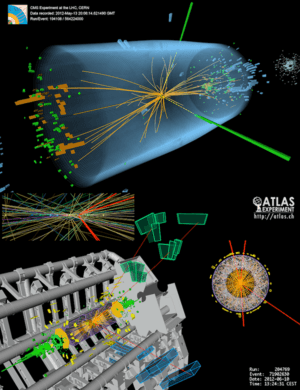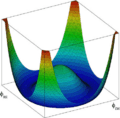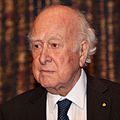Higgs boson facts for kids

|
|
| Composition | Elementary particle |
|---|---|
| Statistics | Bosonic |
| Status | A Higgs boson of mass ≈125 GeV has been tentatively confirmed by CERN on 14 March 2013, although it is unclear as yet which model the particle best supports or whether multiple Higgs bosons exist. |
| Theorised | R. Brout, F. Englert, P. Higgs, G. S. Guralnik, C. R. Hagen, and T. W. B. Kibble (1964) |
| Discovered | Large Hadron Collider (2011-2013) |
| Mass | 125.09±0.21 (stat.)±0.11 (syst.) GeV/c2 (CMS+ATLAS) |
| Mean lifetime | 1.56×10−22 s (predicted) |
| Decays into | bottom-antibottom pair (predicted) two W bosons (observed) |
| Electric charge | 0 e |
| Colour charge | 0 |
| Spin | 0 (tentatively confirmed at 125 GeV) |
| Parity | +1 (tentatively confirmed at 125 GeV) |
The Higgs boson is a tiny particle that helps explain why other particles have mass. It is a key part of the Standard Model of physics, which describes the basic building blocks of the universe.
In the 1960s, Peter Higgs was one of the first scientists to suggest this particle might exist. Scientists at CERN confirmed they had found the particle on March 14, 2013.
Contents
What is the Higgs Boson?
The Higgs boson is one of 17 particles in the Standard Model. It is a type of particle called a boson. Bosons are particles that carry forces. Other well-known bosons include the photon (which carries light) and the gluon (which holds atomic nuclei together).
The Higgs Field
The Higgs boson is linked to something called the Higgs field. Imagine this field as an invisible "sticky" substance that fills the entire universe. Unlike other fields, like the electromagnetic field, the Higgs field is always "on" and has a constant value everywhere.
When other particles move through this Higgs field, they interact with it. This interaction is what gives them their mass. Particles that interact strongly with the Higgs field gain more mass, while those that interact weakly have less mass. Some particles, like photons, don't interact with it at all, which is why they have no mass.
Finding the Higgs Boson
It is very hard to find the Higgs boson. This is because it takes a huge amount of energy to create them. The Large Hadron Collider (LHC) at CERN was built mainly for this purpose.
How the LHC Works
The LHC speeds up two beams of tiny particles, usually protons, to nearly the speed of light. These beams travel in opposite directions. Then, they are made to crash into each other.
Each collision creates many new particles. Scientists use special detectors to study these particles. Finding a Higgs boson is still very rare, about one in 10 billion collisions. So, the LHC has to smash trillions of particles together. Powerful supercomputers then sort through the massive amounts of data to find evidence of the Higgs boson.
Energy and Mass
The creation of a Higgs boson follows the conservation of energy law. This law states that energy is never created or destroyed, only changed from one form to another.
When a particle interacts with the Higgs field, it slows down. This means it loses some of its movement energy, called kinetic energy. This lost kinetic energy is not destroyed. Instead, it turns into mass-energy, which is what we call a Higgs boson.
This idea comes from Albert Einstein's famous equation, E=mc2. This equation shows that mass and energy are two forms of the same thing. The amount of mass created in the Higgs field is exactly equal to the kinetic energy the particle lost. This way, energy is always conserved.
The "God Particle" Nickname
A physicist named Leon Lederman called the Higgs boson the "God particle" in 1993. He used this name to get more attention and support for experiments to find it. However, most scientists do not like this name. The particle has nothing to do with any kind of god, and the nickname can confuse people.
Discovery Timeline
Scientists have been searching for the Higgs boson for decades. Here's a timeline of its discovery:
- December 12, 2011: Two teams at the Large Hadron Collider, called ATLAS and CMS, announced they had seen results that might mean the Higgs boson existed. They were not yet certain.
- July 4, 2012: The LHC teams announced they had discovered a new particle. They believed it was the Higgs boson.
- March 14, 2013: After much more testing, the teams confirmed that the new particle was indeed a Higgs boson.
Images for kids
-
The "Mexican hat-shaped" potential of the Higgs field is responsible for some particles gaining mass.
-
Nobel Prize Laureate Peter Higgs in Stockholm, December 2013
-
"Symmetry breaking illustrated": – At high energy levels (left) the ball settles in the centre, and the result is symmetrical. At lower energy levels (right), the overall "rules" remain symmetrical, but the "Mexican hat" potential comes into effect: "local" symmetry inevitably becomes broken since eventually the ball must at random roll one way or another.
-
Photograph of light passing through a dispersive prism: the rainbow effect arises because photons are not all affected to the same degree by the dispersive material of the prism.
See also
 In Spanish: Bosón de Higgs para niños
In Spanish: Bosón de Higgs para niños




